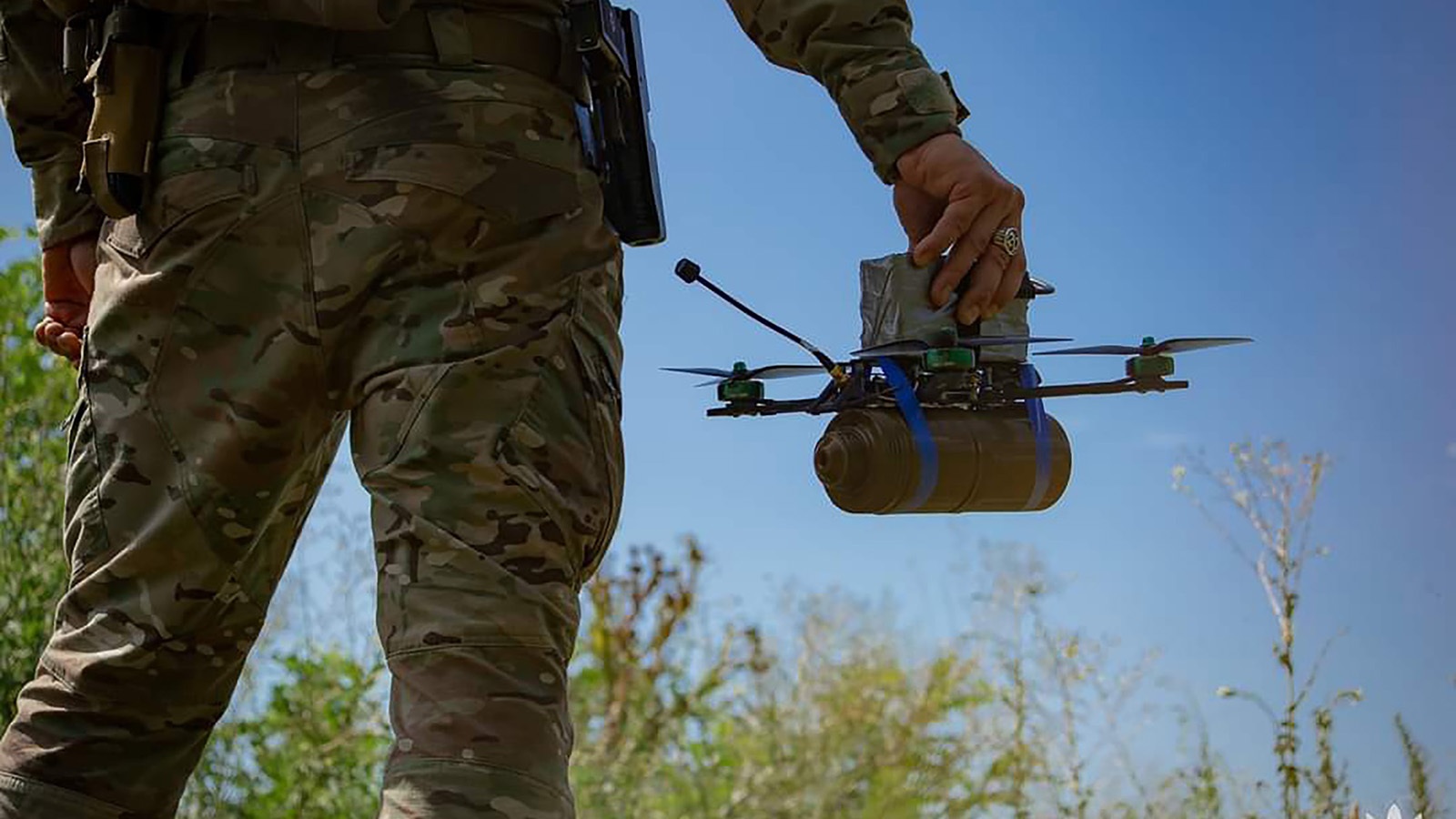Stay Up to Date
Submit your email address to receive the latest industry and Aerospace America news.
On a recent visit to Ukraine, Brian Streem watched Ukrainian soldiers swapping out components of off-the-shelf consumer drones to modify them for battle.
“I’m sitting here watching frontline military guys de-soldering this commercially available device, removing a chip, and I’m like: ‘How the [expletive] did anyone figure this out?’” said Streem, chief executive of Brooklyn-based Vermeer, which manufactures a visual navigation substitute for GPS. “There are certain things that we have absolutely learned about — like how these systems need to be integrated into other subsystems of the drone — that you just don’t know without doing it and without seeing it.”
Historically, experience gained from the battlefield has been applied to future doctrine and technology planning, due to the bureaucratic nature of weapon development and acquisition. But the Russia-Ukraine war has been different. Both countries are rapidly adopting and evolving their technologies and tactics in battle, often updating them in a matter of days.
In the U.S., lessons learned since the start of Russia’s invasion in 2022 have already prompted academia, industry and military customers for the technology to shift their research priorities to reduce development timelines to months or even weeks.
Taking another lesson from the war, advocates for building up U.S. drone production are focusing on developing supply chains to easily source cheap components not made in China.
One means of achieving that objective could also have the side effect of reshaping U.S. airspace. Proponents argue that loosening FAA restrictions on small drones would expand U.S. commercial and consumer use, and thereby boost domestic drone manufacturing capacity.
The war has “changed our whole doctrine about how we’re going to wage drone warfare in the future,” said Jamey Jacob, an Oklahoma State University aerospace engineering professor and small drone and counter-drone researcher. That change, he said, has been driven by “what they’re doing there and how quickly they are doing it, adapting frontline modifications and manufacturing, rethinking everything.”
Learning on the fly
While U.S. researchers and entrepreneurs like Jacob and Streem in the past had been accustomed to developing and fielding new drone technologies on two- to five-year timelines, Ukrainian and Russian soldiers have been adopting modifications and counter-measures within weeks. That’s been the case particularly with small drones, Jacob said.
“We can no longer fight frontline battles like we had in the past,” Jacob said. “We’re seeing what that looks like now and how different that is from what we have prepared for.”
The question now he said, is how the U.S. can make a similar pivot, which includes how to manufacture the millions of small drones and their components that might be required for a future war. The U.S. Army plans to buy 1 million drones within three years, Reuters reported earlier this month, and then potentially ramp up to purchasing at least a half million drones per year, compared to its current outlay for 50,000 drones per year.
The Ukraine war has been “an accelerant” for small drone development in the U.S., especially by the Army and Marine Corps, said Andrew Hunter, a former Air Force acquisition chief who now consults for the defense industry and investors. His clients see a huge opportunity for drone manufacturers, he said.
“They see the effectiveness of what they do as being dramatically demonstrated” by the war, he said.
For Streem, who has five employees in Ukraine and an apartment in Kyiv, the war has also provided real-world development experience and data-gathering opportunities that would have been tough to replicate otherwise. For instance, suppose Vermeer wants to schedule a flight test in the U.S., he said. The company might get some time on “some California missile base next June.”
“Great, that’s nine months away from now,” Streem said. “What else am I supposed to do until then?”
Vermeer is developing software that matches images from visual and infrared cameras, lidar, inertial measurement units and other inputs to digital maps to provide a radio-silent GPS substitute for drones carrying 40-60 kilograms of payload on 1,000-kilometer flights. Perfecting that software requires repetition.
“Getting stuff like this to work requires firing it on drones and missiles a lot, and taking a look at the data, figuring out what worked and what didn’t work, and then why it didn’t work, and then doing it again,” Streem said.
The speed of need
In adopting lessons from Ukraine, DOD and its contractors have placed a premium on quick turnarounds and lower costs per unit.
Some of the funding requirements for small drone research and development for the Air Force, Army and other defense programs have shifted since 2022 to prioritize low-cost options and need-it-yesterday results, said Moble Benedict, a Texas A&M University aerospace engineering professor and owner of Harmony Aeronautics, a drone development company.
“They want very, very rapid turnaround times now. It’s not like a typical DOD kind of program where things happen in years,” Benedict said. “They want these products in months — two months, three months. They’re feeling the urgency to get into this drone space.”
And many small companies are willing to oblige. “They are willing to do anything for success, so they will spend 18-hour days” to meet the stepped-up timelines, he said.
In addition to speedy development, the Pentagon is looking for relatively low-cost tech. Companies pitching counter-drone concepts are asked to present their “cost per kill,” Benedict said.
“If you’re trying to take out a large UAS [unoccupied aerial system], a large asset costing many millions of dollars, you can send a very sophisticated UAS. But do you really want to send a sophisticated UAS to kill a $200 toy drone with a bomb strapped to it?”
Building a small drone from off-the-shelf parts is not complicated, he noted: You need an electric motor for the rotors, a battery, an electronic speed controller to convert the battery voltage for the motor, a power distribution board, a receiver for incoming radio signals, a flight controller to convert those signals to control the aircraft, a GPS receiver, camera, thermal camera, lidar, a 3D-printed frame, screws and wires.
But for that approach to really be cost-effective, the U.S. needs to start domestically mass-producing small drone components, Benedict said. Today, building small drones with parts only from suppliers authorized under the National Defense Authorization Act can be expensive. NDAA compliance means any drone equipment from China, Iran, North Korea or Russia is banned. So the same kind of motor that sells for $20 from a Chinese vendor will cost $100 from a U.S. manufacturer, he said, and U.S.-made electronics for drones are particularly expensive — driving the overall cost of a small drone to upwards of $1,000.
“If you’re free to use the cheapest available motor or the cheapest available battery you can buy online, you can build really cheap drones,” he said. “But then the problem is all these supplies are coming from China.”
One way to incentivize this domestic supply chain could be for FAA to loosen flight restrictions for commercial and recreational small drones, said Clinton Purtel, a business professor and aerospace supply chain expert at Oklahoma State University. This in turn could boost customer demand.
“Industry follows where you can use and scale the thing,” Purtel said, noting that to date, U.S. manufacturers haven’t made large-scale investments in producing small drone components because there’s been no need.
“How do we get the pivot now so the production and specification is there and we don’t have the critical path moment of: ‘Oh crap, now we need it, now we’re in combat?’” Purtel said. “How do we get on a level playing field for these things that are attritable, just no different than firing a round through a gun?”
Part of the reason for the urgency in the U.S. is the surprising lethality and precision that small drones have proven in Ukraine, Benedict said.
“One thing the world realizes right now is the kind of damage these drones can do and the kind targeted attack that these guys can unleash,” he said. “It’s all because the Ukraine war has shown the world what you can do with drones.”
About Keith Button
Keith has written for C4ISR Journal and Hedge Fund Alert, where he broke news of the 2007 Bear Stearns hedge fund blowup that kicked off the global credit crisis. He is based in New York.
Related Posts
Stay Up to Date
Submit your email address to receive the latest industry and Aerospace America news.




